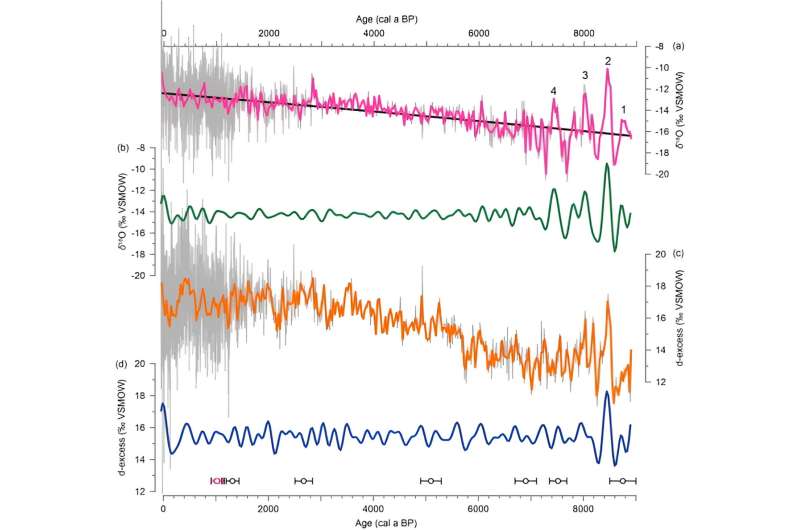This article has been reviewed according to Science X's editorial process and policies. Editors have highlighted the following attributes while ensuring the content's credibility:
fact-checked
trusted source
proofread
Abrupt climate fluctuations in Tibet as imprints of multiple meltwater events during the early to mid-Holocene

A recent study published in the journal Science Bulletin was led by Dr. Shugui Hou (Nanjing University and Shanghai Jiao Tong University) and Dr. Hongxi Pang (Nanjing University). Shugui Hou drilled an ice core with a length of 127.8 m from the Zangser Kangri (ZK) ice cap in the central Tibetan Plateau (TP) in April 2009. The ice core was not well dated until the development of 14C dating technique at the microgram level in glacier ice in the past decade.
The isotopic compositions (δ18O and d-excess) of this core were measured with a spectroscopic water isotope analyzer at Nanjing University. Measurements of 14C were performed on the water-insoluble organic carbon extracted from carbonaceous aerosol particles trapped in ice by the Mini Carbon Dating System at the University of Bern.
The most surprising feature of the ZK ice core record is the dramatic fluctuations of δ18O and d-excess at centennial timescale during 7-9 thousand years ago (the early to mid-Holocene). "I am astonished when I first see the record," Hongxi says.
What reasons can cause the dramatic fluctuations of the ZK isotopic record during the early to mid-Holocene? "The large fluctuations of δ18O were unlikely caused by temperature because the magnitude of temperature change estimated by δ18O if it indicated temperature would be too large to be realistic," Hongxi says.
The solar activities and volcanic eruption events are important forcings for the early to mid-Holocene climate. However, the amplitude of solar variation was not particularly large during the early to mid Holocene than the rest of the Holocene.
In addition, climate variation driven by volcanic eruptions usually occurs at a timescale much shorter than centennial variations observed in the ZK isotopic record, although the Greenland ice cores reveal a great number of volcanic eruptions during 7-9 thousand years ago.
Paleoclimate records and model simulations indicate that glacial meltwater input to the Northern Atlantic during early Holocene ice-sheet decay could weaken the Atlantic Meridional Overturning Circulation (AMOC), leading to abrupt and widespread climate change, such as the widely known 8.2 ka event. After examining a wide range of paleoclimate records, Hongxi, and his colleagues found similar climate fluctuations in many existing records during the early to mid-Holocene, as observed in the ZK isotopic record.
"The most exciting is the rapid four sea-level jumps documented in other records corresponding well with the large fluctuations of the ZK isotopic record; we believe the meltwater forcing during the final stage of LIS dominated the large climate fluctuations in the early to mid-Holocene," Hongxi says.
"Our evidence suggests that at least four rapid meltwater discharge events might have occurred during the final stage of LIS, rather than only the 8.2 ka event previously believed. These rapid meltwater discharge events caused the fluctuations in the position of the mid-latitude westerlies and the Indian Summer Monsoon (ISM) through their impact on the strength of the AMOC, which led to very large fluctuations of the ZK isotopic record in the early to mid-Holocene because the ZK ice cap is in the transition zone between the westerlies and the ISM."
"However, the timing, frequencies, source, and mechanisms of these rapid decay events during the last stage of LIS still require further investigation," Hongxi says.
The finding implies the possibility of rapid sea level rise and unstable climate in the transition zone between the mid-latitude westerlies and the ISM due to fast polar ice retreat under anthropogenic global warming. Therefore, the study has important implications for society's planning and adaptation to future climate change.
More information: Hongxi Pang et al, Abrupt climate fluctuations in Tibet as imprints of multiple meltwater events during the early to mid-Holocene, Science Bulletin (2023). DOI: 10.1016/j.scib.2023.12.007
Provided by Science China Press





















